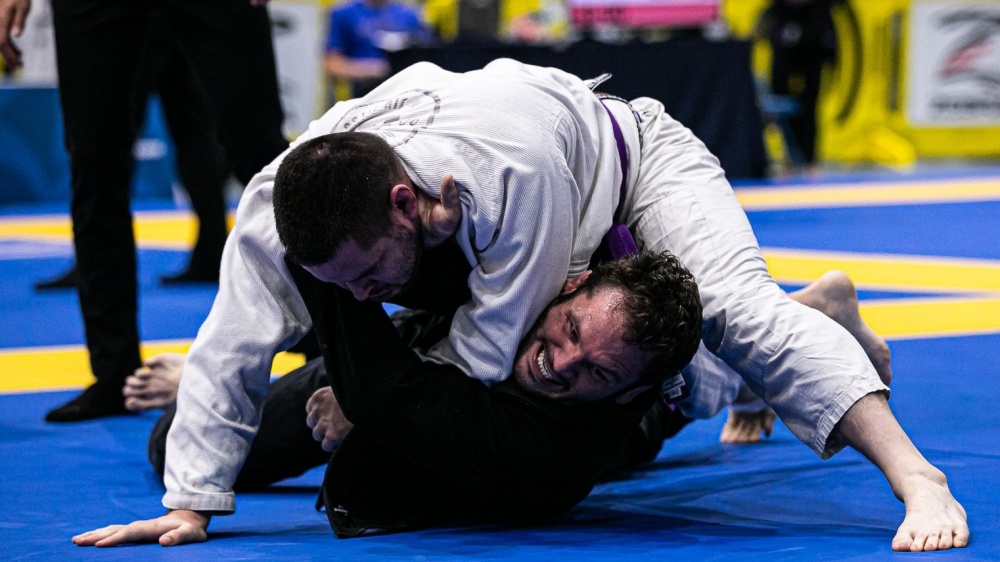The additional grips in gi BJJ open a lot of different options for grapplers. Gi grips can be used to apply different types of guards and are used to prevent the opponent from passing. Even more so, the additional grips you can get by gripping the lapel and collar can set up a submission.
Submissions like the underrated baseball choke are among the most powerful chokes in BJJ. This article will teach you how to apply this sneaky submission that utilizes the opponent’s collar.
What Is The Baseball Choke?
The baseball choke, also known as Ura-Juji-Jime in Judo, is a choke that targets both the trachea and carotid arteries of the neck, making it both a choke (blocking of the airway) and a strangle (disruption of the blood flow in the carotid arteries).
Some techniques are named after things, animals, or the most successful grappler famous for their application. This submission got its name because it is identical to how you grip a baseball bat, but you apply it on the collar of a gi jacket.
The move hit the limelight in 2013 when then fresh black belt Magid Hage used it to submit Zax Maxwell and put Clark Gracie to sleep in the 2013 Abu Dhabi World Pro Trials. Hage received his black belt at 19 and has been using the choke to deal with larger grapplers in his gym since he was 12. It is a versatile submission as it can be applied from both dominant and inferior positions, including the standup.
The baseball choke can generally be seen from the knee on belly position. It can also be applied sneakily from bottom side control. When applied from the bottom position, grapplers don’t usually notice it until it’s a little too late and the choke is already tight, thus putting them to sleep. The choke can also be applied in no-gi, though there are adjustments in the grip because there’s no collar to grab on.
How To Perform The Baseball Choke
The baseball choke is typically applied from the top position together with the knee on belly pin. Magid Hage, a master of the technique, is fond of applying it from the bottom position, especially when the opponent tries to pressure pass.
Assuming that the opponent is trying to pass on your left side with the over under, trapping your left knee, start by framing to recover your guard. Push the opponent away by pushing their shoulder, get your left knee out, and recover. As you push and frame, apply the four-finger grip using your left hand deep inside their left collar.
You may find that the grip is awkward and unusual, but it is what makes the choke sneaky. Use your right hand to grab behind their gi and let the opponent pass. As the opponent moves to your left side to secure side control, do an Upa (bridge) so their head comes up. Bring your left elbow inside and across their neck as their head comes up. Start rolling to your right side as you squeeze.
A strong set of wrists greatly benefits the choke, as most opponents won’t tap to it. It is critical that you hold the grip as long as you can. Magid advises that you do back exercises like the rows with the gi on the barbell or the rowing machine. On the other hand, to defend the choke, it is vital that you focus on breaking the grip first.
Baseball Choke From Top Position
When holding a baseball bat, it is necessary to have your pinky finger touch your index finger at all times. The same can be said when applying the baseball choke from the top position. The baseball choke from top position using the lapel by Jason Yousef is what he refers to as “giving the opponent the option of their own death.”
Starting from top right side control with a cross face, use your left hand to pin the opponent’s head and your right hand to pull their left lapel. Feed their lapel all the way to your left hand, palm down, underneath their head, and behind their shoulder. After feeding, use your right hand to grab their pants to pin them. Assuming that the opponent is using their left hand to frame against your head, as they push your face to create space, use this opportunity to jump up and apply the knee on the belly.
Use your right hand and grab the lapel on top of your left hand. Tighten your grip by moving your right hand’s elbow across their neck as you pinch your elbows. As your elbows tighten, a natural reaction of the opponent is to grab your arms. This is when you pull the opponent in as you dig the knee on belly deeper. Their subsequent response would be to shrimp out, and as they do, drop the knee on belly, which tightens the choke even more.
Again, Yousef reiterates the importance of having your pinky finger touching your index finger as you grip the lapel. It is an absolute must that they do not separate. Think of pulling the lapel apart from itself and pretend like you’re ripping it open by pulling back with both hands when finishing the choke. This will make the choke even tighter because your elbows are going to pinch as you do the same thing, making the forearm blade go right across the opponent’s carotid arteries.
Conclusion
If you’re keen on adding the baseball choke to your BJJ repertoire, dont forget to speak to your coach about it. Having the gi makes the playing field more playful and safe, especially for grapplers who are smaller or past their prime years. As Georges St-Pierre said, the best way to improve is when the environment is playful. So as you learn and practice the baseball choke, keep things light and fun!
You may also like:

















